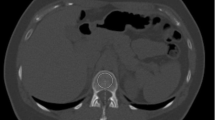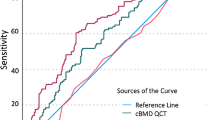Abstract
Summary
This study evaluated the use of low-dose chest computed tomography (LDCT) for detecting bone fragility. LDCT-measured vertebral bone attenuation by volumetric methods showed good correlation with bone mineral density (BMD) measured by dual-energy x-ray absorptiometry (DXA, and good diagnostic performance for identifying osteoporosis and compression fractures. The results of this study suggest the feasibility of obtaining comprehensive information on bone health in subjects undergoing LDCT.
Introduction
Osteoporosis is a prevalent but underdiagnosed disease that increases fracture risk. This study evaluated the utility of vertebral attenuation derived from low-dose chest computed tomography (LDCT) compared to dual-energy x-ray absorptiometry (DXA) for detecting bone fragility.
Methods
A total of 232 subjects (78 men and 154 women) aged above 50 years who underwent both LDCT and DXA within 30 days were evaluated. LDCT-measured bone attenuation in Hounsfield units (HU) of four vertebrae (T4, T7, T10, and L1) was evaluated using volumetric methods for correlation with DXA-measured bone mineral density (BMD) and for the diagnosis of compression fractures, osteoporosis, and low BMD (osteoporosis or osteopenia) in men and women, with DXA measurements as the reference standard.
Results
The average attenuation of the four vertebrae showed strong correlation with DXA-measured BMD of the lumbar spine (r = 0.726, p < 0.05). In receiver-operating characteristic (ROC) analyses, the area under the curve (AUC) across LDCT-measured thresholds of the average attenuation to distinguish compression fractures was 0.827, and a threshold of 129.5 HU yielded 90.9 % sensitivity and 64.4 % specificity. Similarly, average attenuation showed high AUCs and good diagnostic performance for detecting osteoporosis and low BMD in both men and women. Among 44 subjects with compression fractures, the average bone attenuation showed strong negative correlation with both the worst fracture grade (r = −0.525, p < 0.05) and cumulative fracture grade score (r = −0.633, p < 0.05).
Conclusion
LDCT-measured bone attenuation by volumetric methods showed good correlation with BMD measured by DXA and good diagnostic performance for identifying bone fragility.



Similar content being viewed by others
References
World Health Organization (2003) Prevention and management of osteoporosis. World Health Organization, Geneva
Cooper C, Cole ZA, Holroyd CR et al (2011) Secular trends in the incidence of hip and other osteoporotic fractures. Osteoporos Int 22(5):1277–1288
Raisz LG (2005) Clinical practice. Screening for osteoporosis. N Engl J Med 353(2):164–171
Reginster JY, Burlet N (2006) Osteoporosis: a still increasing prevalence. Bone 38(2 Suppl 1):S4–S9
Lee YK, Yoon BH, Koo KH (2013) Epidemiology of osteoporosis and osteoporotic fractures in South Korea. Endocrinol Metab (Seoul) 28(2):90–93
Lewiecki EM, Gordon CM, Baim S et al (2008) International Society for Clinical Densitometry 2007 adult and pediatric official positions. Bone 43(6):1115–1121
Schousboe JT, Shepherd JA, Bilezikian JP, Baim S (2013) Executive summary of the 2013 international society for clinical densitometry position development conference on bone densitometry. J Clin Densitom 16(4):455–466
Siris ES, Adler R, Bilezikian J et al (2014) The clinical diagnosis of osteoporosis: a position statement from the National Bone Health Alliance Working Group. Osteoporos Int 25(5):1439–1443
Zhang J, Delzell E, Zhao H et al (2012) Central DXA utilization shifts from office-based to hospital-based settings among medicare beneficiaries in the wake of reimbursement changes. J Bone Miner Res 27(4):858–864
Gourlay ML, Fine JP, Preisser JS et al (2012) Bone-density testing interval and transition to osteoporosis in older women. N Engl J Med 366(3):225–233
Pickhardt PJ, Lee LJ, del Rio AM et al (2011) Simultaneous screening for osteoporosis at CT colonography: bone mineral density assessment using MDCT attenuation techniques compared with the DXA reference standard. J Bone Miner Res 26(9):2194–2203
Pickhardt PJ, Pooler BD, Lauder T, del Rio AM, Bruce RJ, Binkley N (2013) Opportunistic screening for osteoporosis using abdominal computed tomography scans obtained for other indications. Ann Intern Med 158(8):588–595
Romme EA, Murchison JT, Phang KF et al (2012) Bone attenuation on routine chest CT correlates with bone mineral density on DXA in patients with COPD. J Bone Miner Res 27(11):2338–2343
Buckens CF, de Jong PA, Mali WP, Verhaar HJ, van der Graaf Y, Verkooijen HM (2014) Prevalent vertebral fractures on chest CT: higher risk for future hip fracture. J Bone Miner Res 29(2):392–398
Buckens CF, Dijkhuis G, de Keizer B, Verhaar HJ, de Jong PA (2015) Opportunistic screening for osteoporosis on routine computed tomography? An external validation study. Eur Radiol 25(7):2074–2079
Kubo T, Lin PJ, Stiller W et al (2008) Radiation dose reduction in chest CT: a review. AJR Am J Roentgenol 190(2):335–343
Wille MM, Thomsen LH, Dirksen A, Petersen J, Pedersen JH, Shaker SB (2014) Emphysema progression is visually detectable in low-dose CT in continuous but not in former smokers. Eur Radiol 24(11):2692–2699
Rivera MP, Mehta AC, Wahidi MM (2013) Establishing the diagnosis of lung cancer: diagnosis and management of lung cancer, 3rd ed: American College of Chest Physicians evidence-based clinical practice guidelines. Chest 143(5 Suppl):e142S–e165S
Ohara T, Hirai T, Muro S et al (2008) Relationship between pulmonary emphysema and osteoporosis assessed by CT in patients with COPD. Chest 134(6):1244–1249
Graat-Verboom L, Wouters EF, Smeenk FW, van den Borne BE, Lunde R, Spruit MA (2009) Current status of research on osteoporosis in COPD: a systematic review. Eur Respir J 34(1):209–218
Rosset A, Spadola L, Ratib O (2004) OsiriX: an open-source software for navigating in multidimensional DICOM images. J Digit Imaging 17(3):205–216
Rosset C, Rosset A, Ratib O (2005) General consumer communication tools for improved image management and communication in medicine. J Digit Imaging 18(4):270–279
Genant HK, Wu CY, van Kuijk C, Nevitt MC (1993) Vertebral fracture assessment using a semiquantitative technique. J Bone Miner Res 8(9):1137–1148
Oei L, Rivadeneira F, Ly F et al (2013) Review of radiological scoring methods of osteoporotic vertebral fractures for clinical and research settings. Eur Radiol 23(2):476–486
Bland JM, Altman DG (1986) Statistical methods for assessing agreement between two methods of clinical measurement. Lancet 1(8476):307–310
Carberry GA, Pooler BD, Binkley N, Lauder TB, Bruce RJ, Pickhardt PJ (2013) Unreported vertebral body compression fractures at abdominal multidetector CT. Radiology 268(1):120–126
National Osteoporosis Foundation (2014) Clinician’s guide to prevention and treatment of osteoporosis. National Osteoporosis Foundation, Washington, DC
Fidler JL, Murthy NS, Khosla S et al (2015) Comprehensive assessment of osteoporosis and bone fragility with CT colonography. Radiology 278(1):172–180
de Torres JP, Bastarrika G, Wisnivesky JP et al (2007) Assessing the relationship between lung cancer risk and emphysema detected on low-dose CT of the chest. Chest 132(6):1932–1938
Raviv S, Hawkins KA, DeCamp MM Jr, Kalhan R (2011) Lung cancer in chronic obstructive pulmonary disease: enhancing surgical options and outcomes. Am J Respir Crit Care Med 183(9):1138–1146
Looker AC, Melton LJ 3rd, Borrud LG, Shepherd JA (2012) Lumbar spine bone mineral density in US adults: demographic patterns and relationship with femur neck skeletal status. Osteoporos Int 23(4):1351–1360
Wu XP, Liao EY, Huang G, Dai RC, Zhang H (2003) A comparison study of the reference curves of bone mineral density at different skeletal sites in native Chinese, Japanese, and American Caucasian women. Calcif Tissue Int 73(2):122–132
Hayashi T, Chen H, Miyamoto K et al (2011) Analysis of bone mineral density distribution at trabecular bones in thoracic and lumbar vertebrae using X-ray CT images. J Bone Miner Metab 29(2):174–185
Jarvinen TL, Sievanen H, Khan KM, Heinonen A, Kannus P (2008) Shifting the focus in fracture prevention from osteoporosis to falls. BMJ 336(7636):124–126
Johnell O, Kanis JA, Oden A et al (2005) Predictive value of BMD for hip and other fractures. J Bone Miner Res 20(7):1185–1194
Kanis JA, Johnell O, Oden A, Johansson H, McCloskey E (2008) FRAX and the assessment of fracture probability in men and women from the UK. Osteoporos Int 19(4):385–397
Dawson-Hughes B, Tosteson AN, Melton LJ 3rd et al (2008) National Osteoporosis Foundation Guide Committee. Implications of absolute fracture risk assessment for osteoporosis practice guidelines in the USA. Osteoporos Int 19(4):449–458
Birnbaum BA, Hindman N, Lee J, Babb JS (2007) Multi-detector row CT attenuation measurements: assessment of intra- and interscanner variability with an anthropomorphic body CT phantom. Radiology 242(1):109–119
Sande EP, Martinsen AC, Hole EO, Olerud HM (2010) Interphantom and interscanner variations for Hounsfield units—establishment of reference values for HU in a commercial QA phantom. Phys Med Biol 55(17):5123–5135
Summers RM, Baecher N, Yao J et al (2011) Feasibility of simultaneous computed tomographic colonography and fully automated bone mineral densitometry in a single examination. J Comput Assist Tomogr 35(2):212–216
Author information
Authors and Affiliations
Corresponding author
Ethics declarations
Conflict of interest
Yeon Wook Kim, Jung Hee Kim, Soon Ho Yoon, Ji Hyun Lee, Chang-Hoon Lee, Chan Soo Shin, and Young Sik Park declare that they have no conflict of interest.
Additional information
Yeon Wook Kim and Jung Hee Kim contributed equally to this work.
Electronic supplementary material
Below is the link to the electronic supplementary material.
Supplementary Figure 1
Bland-Altman plots of a inter-observer and b intra-observer variability of the average bone attenuation measured from a single ROI per vertebra. (ZIP 1211 kb)
Rights and permissions
About this article
Cite this article
Kim, Y.W., Kim, J.H., Yoon, S.H. et al. Vertebral bone attenuation on low-dose chest CT: quantitative volumetric analysis for bone fragility assessment. Osteoporos Int 28, 329–338 (2017). https://doi.org/10.1007/s00198-016-3724-2
Received:
Accepted:
Published:
Issue Date:
DOI: https://doi.org/10.1007/s00198-016-3724-2




